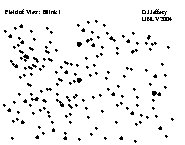 Percival Lowell (1855-1916).
Percival Lowell (1855-1916).
Lowell a member of the famous Massachusetts Lowell family was one of the last great astronomer magnates. He was an enthusiastic promoter of the theory of canals of Mars and did many observations from his own Lowell Observatory in Flagstaff, Arizona.
Lowell was an eager searcher for the Planet X (FMW-237---239).
He tried to calculate the Planet X's orbit and position from apparent unaccounted-for perturbations of Uranus and Neptune. His calculations were wrong and nowadays with modern data we do not believe any unaccounted-for perturbations exist (No-431).
His search from 1906 until his death 1916 in was fruitless.
Lowell Observatory continued the quest, however, with a dedicated search.
Credit: late-19/early-20th century photographer; download site: Eric Hutton's site Mars by Percival Lowell, 1895.
 Young Clyde Tombaugh (1906--1997)
Young Clyde Tombaugh (1906--1997)
This image of Clyde with his home-made telescope is from 1928 and may be public domain if the photographer passed on before 1934: maybe no one even remembers who that was.
Credit: ?; custodian; New Mexico State University Library, Archives and Special Collections; download site Clyde Tombaugh Biography at New Mexico State University.
 A cartoon of Clyde Tombaugh (1906--1997): portrait of a scientist as
a young nerd.
A cartoon of Clyde Tombaugh (1906--1997): portrait of a scientist as
a young nerd.
In 1930, the 24 year-old CLYDE TOMBAUGH at Lowell Observatory discovered PLUTO using a blink comparator discovered Pluto within 6 degrees of Lowell's prediction (FMW-238--239).
The proximity of PLUTO to Lowell's prediction was just an accident.
Lowell's calculations were wrong and Pluto as it turns out is far too low-mass to be a major perturber of Uranus and Neptune.
PLUTO was named for the Roman god of the Underworld. This is appropriate given Pluto's remoteness in the darkness of space.
But also because the first two letters of Pluto are Percival Lowell's initials and, perhaps, because as a wealthy man---a Boston Brahmin---Lowell could be characterized as a PLUTOCRAT.
The symbol for PLUTO is combination of P and L.
 Pluto and its satellite Charon from Gemini North.
Pluto and its satellite Charon from Gemini North.
The Gemini North telescope is on Mauna Kea in Hawaii. There are 4 near-infrared images (K-band which is centered on 2.2 microns): these were obtained on different nights in 1999jun. The maximum separation of the objects is 0.9 arcseconds.
Credit: Gemini Observatory, US National Science Foundation.
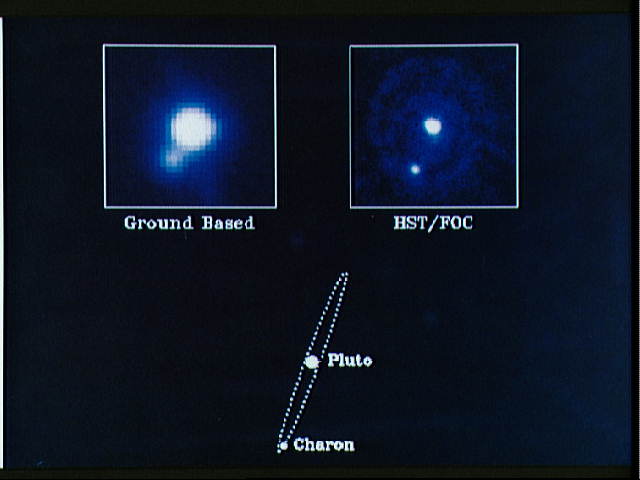 Pluto and its satellite Charon from the ground and the HST.
Pluto and its satellite Charon from the ground and the HST.
The image at the upper right was the first long-exposure HST image of a target moving with respect to the fixed stars. It was taken 1990oct23.
The ground-based image in the upper right is from the Canada-France-Hawaii Telescope on Mauna Kea in Hawaii. It has about the best resolution from the ground available in 1990.
The diagram at the bottom shows the Charon's orbit in the same orientation as in the images (HI-239).
Pluto's equatorial radius is 1195 km (0.180 Earth radii); Charon's radius is 593 km; Charon's mean distance from Pluto is 19,600 km (3.07 Earth radii) (Cox-295, 305, 306). Credit: NASA/HST.
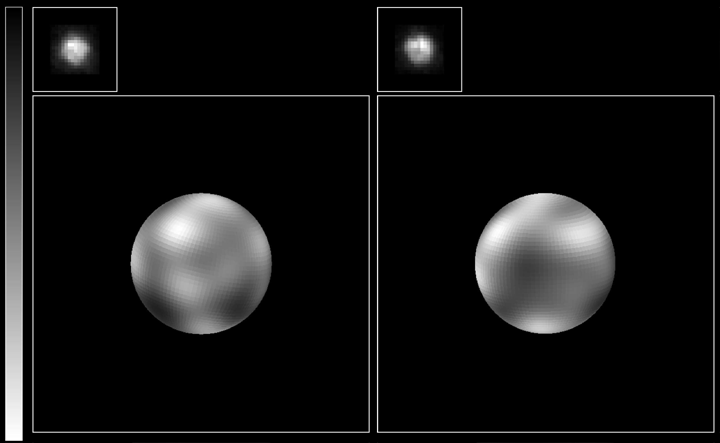 Resolved images of Pluto from the HST, 1994jun/jul.
Resolved images of Pluto from the HST, 1994jun/jul.
These images show the first resolved surface features on Pluto. The two images show opposite hemispheres with north up. The small images are the top are the raw images before processing.
Pluto has a diameter of 2390 km and the pixel size is 150 km.
The color variations are probably caused by topographic features and/or surface composition. Pluto is mostly covered by nitrogen ice (N_2 ice which requires temperatures below about 63.25 K (HI-239; CAC-54]). The surface temperature ranges from about 60 K at perihelion to 50 K at perihelion (FMW-238).
The surface may interact with the atmosphere which is mainly N_2 with perhaps some methane (PF-156).
The atmosphere may freeze out circa 2010--2020 when Pluto moves farther from the Sun (PF-156). Pluto is at its warmest near perihelion which occurred 1989sep05 (Cox-295).
Credit: NASA/HST.
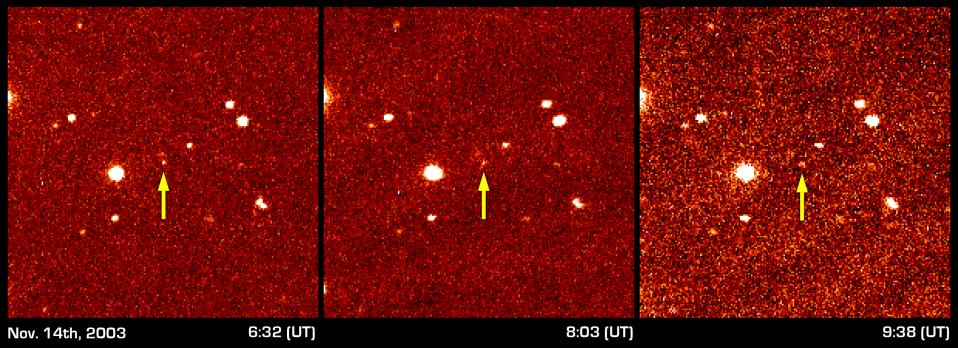 Discovery images of Sedna.
Discovery images of Sedna.
Sedna is a trans-Neptunian object discovered 2003nov14.
These images show Sedna moving against the background of the fixed stars. This shows that it is a solar system body.
It is quite large. Probably of order 1500 km in diameter, but still significantly smaller than Pluto.
Little is known about Sedna, but spectroscopy tells us that it is reddish.
Credit: NASA/Caltech: Image #PIA05568.
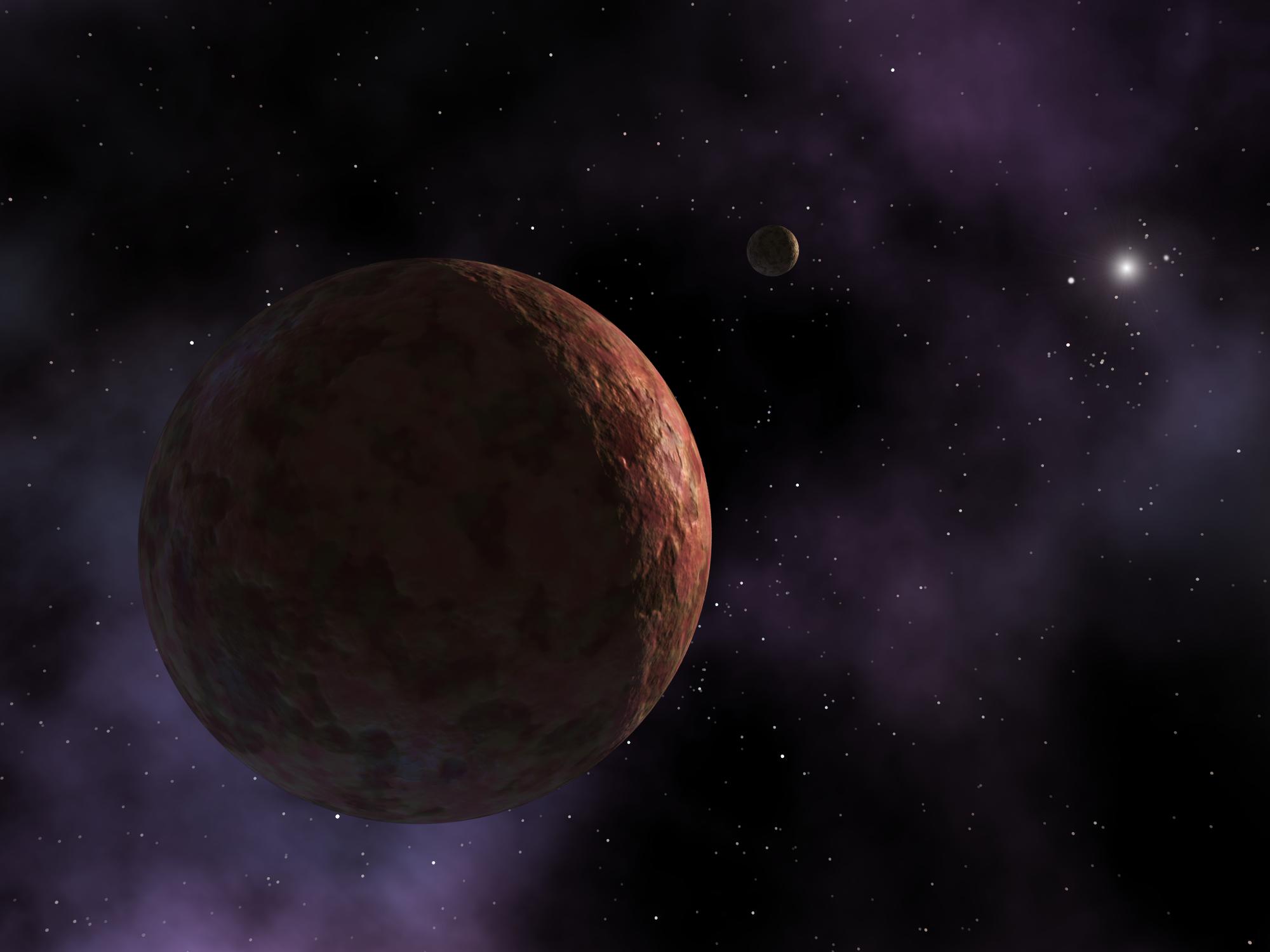 An artist's conception of Sedna from 2004.
An artist's conception of Sedna from 2004.
Sedna is a trans-Neptunian object discovered 2003nov14.
It is quite large. Probably of order 1500 km in diameter, but still significantly smaller than Pluto.
Little is known about Sedna, but spectroscopy tells us that it is reddish.
From Sedna, the Sun appears as bright star and not a disk.
Early on there was some evidence that Sedna had a moon and the artist as put it in the image. It is the crescent.
Credit: R. Hurt/NASA/JPL-Caltech: Image #PIA05566.
 An artist's conception the Kuiper Belt and the Oort Cloud.
An artist's conception the Kuiper Belt and the Oort Cloud.
The Kuiper Belt is an torus-like region of icy planetesimals beyond about the orbit of Neptune.
The Oort Cloud is a spherical halo of icy planetesimals that extend from about 20,000 AU to 100,000 AU from the Sun (Se-569).
Kuiper Belt objects have been discovered since 1992 or 1930 if you count Pluto as one which one probably should.
The Oort Cloud is entirely theoretical. No object belonging to it has ever been found. They are too faint and remote for current technology.
But the Oort Cloud must exist as the source of long-period comets.
The image shows the Oort Cloud with some structure: probably this is based on some analysis.
Credit: NASA/Donald K. Yeomans; download site: Views of the Solar System. The Views site is a commercial site by Calvin J. Hamilton has many public domain images. CJH has done a good job of collecting NASA images that are hard to locate at NASA's own sites.
